Decades ago, when I was a medical student at Southampton, I joined an expedition that, usually at the time, was granted permission to carry out wildlife research in Madagascar. I’d known the Great Red Island as a world like no other since Attenborough’s Zoo Quest to Madagascar., but following Independence from France, the country had courted Russia and for a decade or so visits from Western researchers were discouraged.
We though happened to apply to work there at the beginning of a new more open policy, in 1981. Intent on contributing to the knowledge of lemur ecology, we visited two forested areas 1000 miles apart. The second was snuggled in the shelter of the sheer limestone cliffs of the Ankarana Massif in the north of Madagascar.
We camped in a yawning cave entrance and found ourselves sharing a water supply with lemurs that hadn’t learned to fear humans, although their big round eyes did make them look constantly startled. The males had a striking black triangle of fur between their teddy-bear ears and the females a chestnut tiara; these were Crowned Lemurs. At the time I assumed that such engaging and unshy mammals would have been studied by primatologists of international standing so I concentrated on documenting the less obviously attractive invertebrates inhabiting the caves. Yet the caves that riddled the massif gave us access to a sunken forest and otherwise inaccessible luxuriant gorges which acted as natural nature reserves for lemurs and other wildlife; it became clear that this was a very special environment within Madagascar’s other-worldly island-continent.
 |
| A male Crowned Lemur, Eulemur coronatus |
 |
| Female Crowned Lemurs are very much in charge |
Only later did I discover that the elegant Crowned Lemurs who daily visited the pool where we’d camped hadn’t ever been studied in the wild by zoologists. I resolved to return to Study them, document their behaviour, attempt to assess how threatened they were and how restricted in their geographical distribution and range. Such research would enable biologists to understand how best to conserve a species that was, in common with many lemur species, likely to be endangered.
It took five years to assemble a suitable scientific team for the return expedition. They needed to be biologists capable of living in the forest for a month or two as well as competent cavers who could organise a rescue if needed. The environment was remote and the landscape hostile and, if there was an accident, we couldn’t expect help with any evacuation.
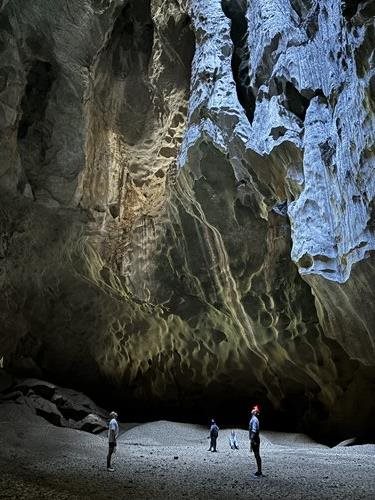 |
| Andrafiabe Cave comprises chambers over 150m high, some lit by daylight |
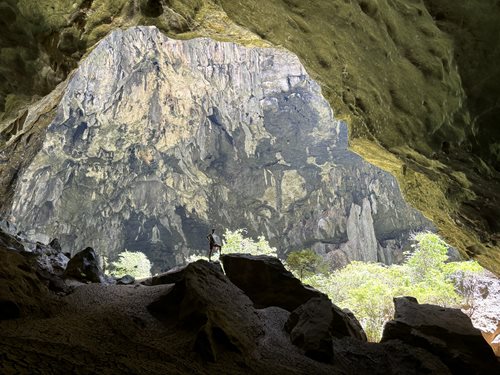 |
| The Andrafiabe Cave system was been cracked into three sections during eruptions of Montagne d'Ambre at least ten million years ago. Note Alex for scale |
The Ankarana Massif is small but moving around proved challenging. I’d at first assumed we might enter sunken forests by crossing the limestones and perhaps abseilling into them, but although there were places where it was possible to summit the massif, the surface was fakir’s nail-bed of points which ripped boots to pieces in weeks. The spiky rock is known locally as
tsingy meaning walking on tiptoes, which we never learned to do. Yet we could see that all manner of weird-looking bottle-bottomed, drought-resistant plants clung on up there.
During this second expedition, we based ourselves in a forested canyon at a spot that is still known as
Le Campement des Anglais. When we attempted to estimate the number of Crowned Lemurs in this part of the forest, their population density appeared to be the highest recorded for any wild primates globally, and this was without trying to count mouse lemurs, sportive lemurs and others which also shared the area.
As we became familiar with the terrain, it became clear that the unusually high density of lemurs was a seasonal phenomenon. During the dry season the surface of the massif is parched and lacerating and the few plants that can survive up there are leafless while the surrounding savannah also provides little nutrition for hungry herbivores. The gorges and canyons and isolated forests within the massif, remain green though because are irrigated by subterranean rivers and so provide good foraging opportunities for the lemurs.
When the rains come the lemurs expand their range, skilfully negotiating the ferocious
tsingy to browse on the blossoming and fruiting plants growing out of the cracks and crevices of the limestones. Even bare rock becomes covered in mosses and bryophytes which in turn feed grazing snails and other invertebrates so omnivorous lemurs enjoy protein-rich snacks to augment a fig-rich diet.
Until our study, zoologists had assumed that Crowned Lemurs were only active during daylight hours, but we slept in hammocks and were made aware that this species like to eat in the middle of the night too. Around 2am there would be activity in the canopy above our camp and half-eaten fruit and a certain amount of poo would rain down on us.
As well as completing and publishing the first study of wild Crowned Lemurs, we compiled a list of the other animals present and this ecological inventory helped emphasise the zoological importance of Ankarana. It had been designated as a Special Reserve in 1956, during the French colonial era, but by the 1980s there was no protection that should have accompanied that status. Partly due to our efforts, WWF funded the employment of rangers to patrol the reserve on mountain bikes for a while, and over time, the area was recognised as being worthy of National Park status.
When I returned to Ankarana in September 2024, it was a delight to spend time again with lemurs in their home territory, watching them move around the forest grunting good-naturedly to keep in contact with the rest of the troop. Their opposable thumbs and lolly-pop-tipped fingers and toes cushion and facilitate branch and tree-trunk grabbing after prodigious leaps while their big amber eyes forever look as if they had just heard some shocking gossip.
Our guide for our three-week return trip was the personable Mika who entertained us with stories and enthusiastically shared his extensive knowledge of his homeland. He was originally from the south-west and said his Merina colleagues from the central highlands weren’t keen on accompanying us as I’d expressed enthusiasm to re-visit some of Ankarana’s caves which supposedly hold a curse that will make any Merina person who enters dangerously ill, or they might even die.
 |
| A silent sleepy nocturnal sportive lemur at Ankarana |
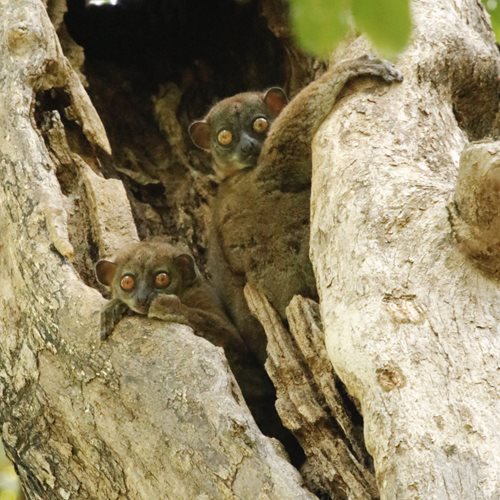 |
| Mum and youngster: sportive lemurs at Ankarana always looking mildly apprehensive |
I wondered what I’d find on our 2024 visit as proper protection of key reserves isn’t easy when government needs to balance competing priorities and pressures. Forests that grow valuable tropical hardwoods can provide rich pickings for people motivated by profit over conservation or development of wildlife tourism. Furthermore, disastrous cyclones or drought may force subsistence agriculturalists to look to the forest for resources to help them survive. Yet traditions are effective in protecting some species.
Hearteningly there have been excellent developments since I was last in Madagascar. There are now forest corridors between Ankarana and other areas where lemurs thrive. On the east side of the massif there is a staffed park headquarters and from there we employed Gautier, an expert wildlife guide who was impressive in his knowledge and ability to spot well-camouflaged animals, indeed in our heat-sapped state, he was far more enthusiastic about showing us everything than we were. In the 1980s we had camped in the forest for a couple of months but Gautier showed me how much we had missed during our researches. There were chameleons and diminutive 50g mouse lemurs everywhere!
 |
| Diminutive mouse lemurs are busy throughout the night - photo by Simon Howarth |
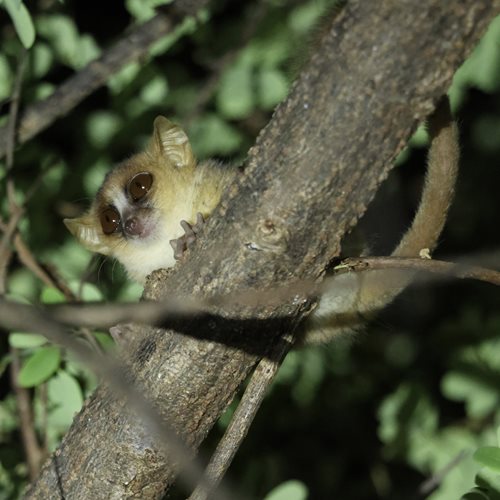 |
| Mouse lemurs are fast-moving and challenging to photograph - photo by Simon Howarth |
We walked right through the massif from the
Campement des Anglais, west to east along a forested canyon that in the 1980s had been so tangled and hard to negotiate as we had to hack through dense undergrown and lianas with blunt machetes. Now though it an easy stroll along a wide track. We came out at the
Campement des Princes where we settled down to lunch and Gautier produced bananas, which soon produced Crowned Lemurs climbing over us, eager to grab their share. Initially we were delighted that they came so close, but then I wondered whether it is right to encourage wild animals to become so habituated to human company.
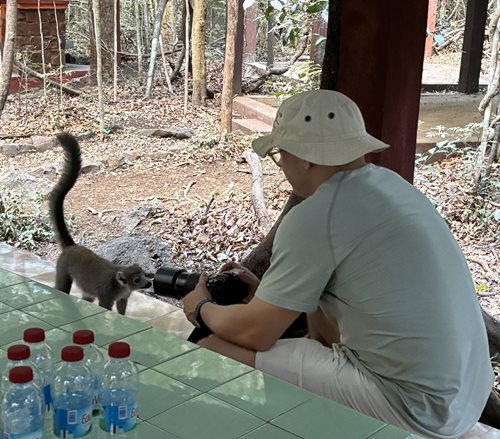 |
| A curious female Crowned Lemur hoping for bananas at the Campement des Princes |
Several lodges have been built close to the Ankarana park headquarters along Route National Six including one with its own private “domaine”. Here Nando, local wildlife enthusiast-cum-barista, took us on a tour of their protected patch of
tsingy; he pointed out reptiles and birds, and gave scientific names to rare plants.
Now that the Ankarana Massif is attracting wildlife tourists, conservation is seen as worthwhile. I hope that now money can be made from local and foreign visitors, this will be a force for conservation and may help resist those who would otherwise extract valuable ebonies and rosewoods from Madagascar’s rich but threatened forests.
Some traditions also help protect precious lemurs and other wildlife, as long as drought and famine in other parts of Madagascar don’t force desperate, internally displaced people to resort to exploiting delicate habitats and eating “bush meat”.
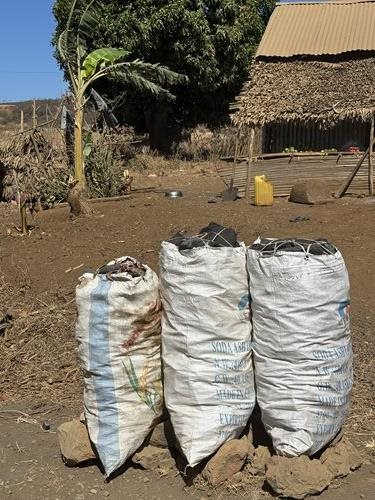 |
| Wood cut from the forest is turned into charcoal for cooking fuel |
There is more about our trip here
Nosy Be to Nosy Hara and a piece of creative writing about Madagascar is here
Deep emerald green. There is also a blog about several days we spent in eastern rainforest here
Into the Malagasy Rainforest. AND even more about Crowned Lemurs living further east of Ankarana here
Celebrities of the Dry Deciduous Forest
My March post asks questions about the complexities on deciding which are the best ways to conserve lemurs; for this click
Wildlife Tourism and Conservation Conundrums
I have also posted some Madagascar wildlife photos from our 2024 trip on my Instagram pages @longdropdoc